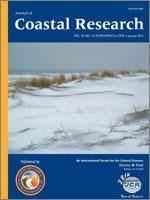Surface discharge of negatively buoyant effluents into moving waterbodies creates a range of complex flow behavior. These complexities in the hydrodynamic phenomena develop through the interplay between a discharge's initial fluxes and the motion of the ambient current, which advects the discharge fluid downstream. In the present study, experiments were conducted for a comprehensive range of initial fluxes for negatively buoyant discharges in an ocean current through rectangular and semicircular channels. From this data, three flow regimes—the free surface jet, the shore-attached surface jet, and the plunging plume—and their range of occurrences were identified. These observations provide the basis for developing a revised flow classification diagram, which differs significantly from the positively buoyant discharge scheme as expected. A major difference is in the transition from the free surface jet regime to the shore-attached surface jet, whereas the plume-like regime has the same transition criteria. Eventually, using the developed diagrams, an initial tree-like classification framework is developed for both semicircular and rectangular discharge channels.
How to translate text using browser tools
1 January 2012
Flow Classification of Negatively Buoyant Surface Discharge in an Ambient Current
Ozeair Abessi,
Mohsen Saeedi,
Mark Davidson,
Naser Hajizadeh Zaker
ACCESS THE FULL ARTICLE

Journal of Coastal Research
Vol. 28 • No. 1A
January 2012
Vol. 28 • No. 1A
January 2012
dense jet
Flow regime
marine outfalls
surface flows




